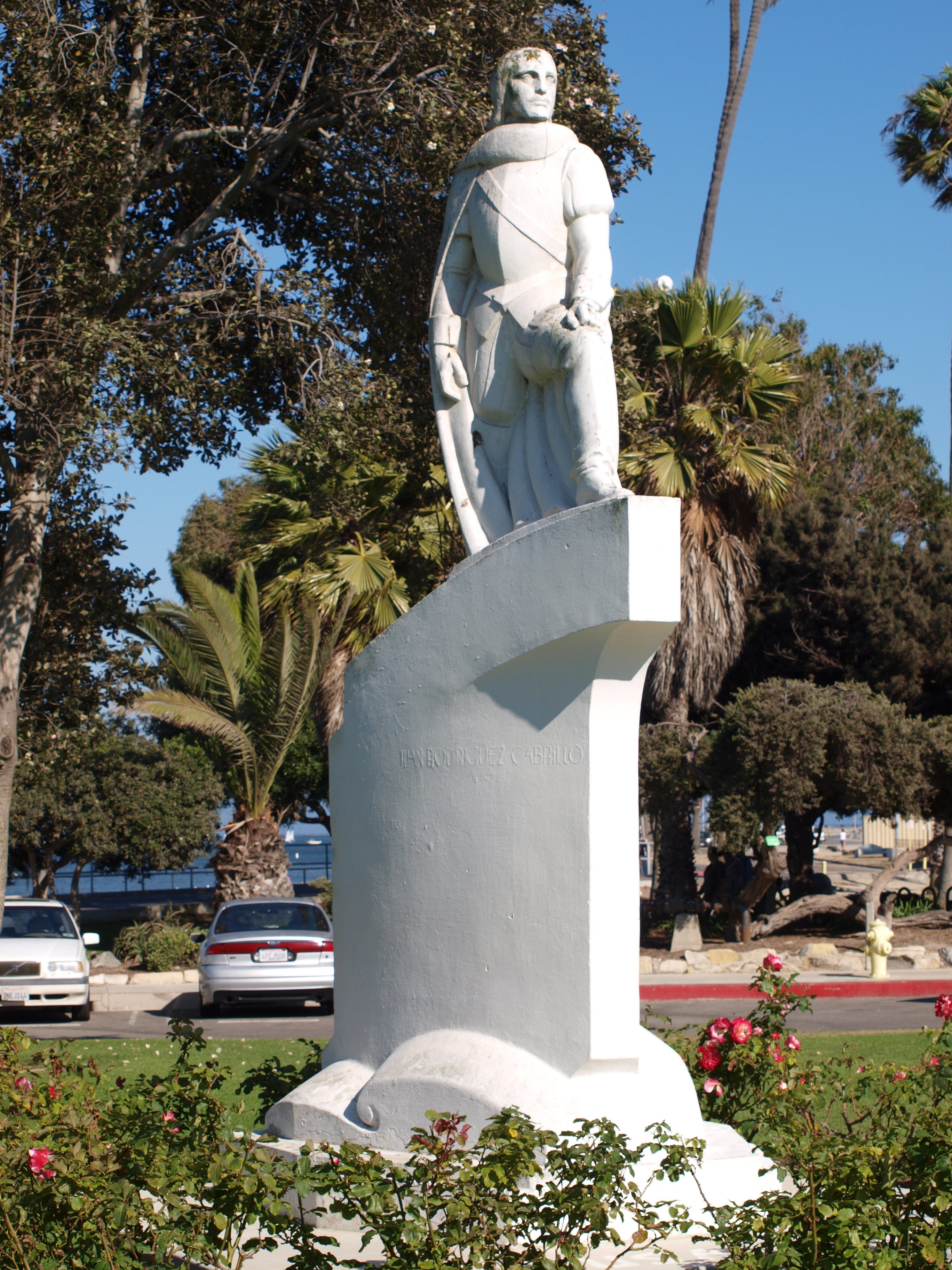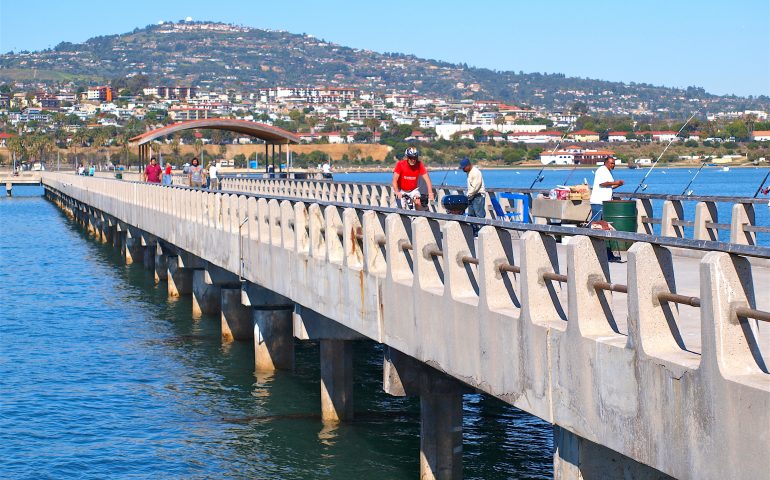While the crew watched — hardly daring to breathe — and Clay McKinley stood ready with the shovel, Herrick studied the blueprint, found a mysterious X, then pointed to the earth a yard or so from Clay McKimley’s feet, and said: “Dig here!” “CLANG! SCRAPE!” went the shovel against the gravelly earth. “Ah!” exclaimed the crowd, finally catching a breath.
And that’s how the kids — a batch of them, as it happened, from Adams school in Torrance — Tuesday afternoon officially broke ground at Cabrillo Beach, San Pedro, for the million-dollar kids’ fishing pier. Well almost a million. Atkinson got the contract from the Los Angeles City Department of Recreation and Parks at $758,133. And of course, old folks will fish from the pier too, once it’s finished a year from now.
Herrick told the young visitors about the pier. “It will be 1,200 feet long. We think it will give fishing space for 1,000 fishermen at a time. We are going to put floodlights under the pier to attract fish. When the red tape has been cut, the forthcoming pier will have been paid for by city, state and federal funds. It will be the first major recreation construction at Cabrillo Beach since 1930.
San Pedro’s chapter of the Izaak Walton League, which has carried the pier fight since first proposing such a pier back in 1963, claims the pier-to-be will provide lucky anglers with herring, anchovies, kingfish, turbot, opal-eye, kelp and rock bass, cabezon, perch, smelt, bonito and other kinds of fish.
The Atkinson Company will start construction of the pier at 7:30 a.m. today by grading a road and installing utility lines. A pile-driver soon will start driving the first of 117 steel-reinforced octagonal concrete pilings 25 feet into the sand. The pier will stand on the sheltered side of the San Pedro Breakwater in water ranging from 15 to 40 feet deep. It will be open to anyone day and night without fee, under city police supervision. —Dick Emery, Long Beach Press-Telegram, October 9, 1968
Cabrillo Beach Fishermen Land a Spanking New Pier
The grownups and children who fish at Cabrillo Beach hooked a really big one Thursday — a brand new $825,000 pier. They didn’t throw it back, but reeled it in —all 1,200 feet of the Cabrillo Beach Fishing Pier they’d been dreaming about for five years. There was a formal dedication ceremony at which Los Angeles City Councilman John S. Gibson Jr. presented the pier to retired newspaperman Charles Crawford, who sparked the five-year campaign to have the structure built.
The beaming Crawford thanked Gibson and promptly gave the pier “right back to the people.” “The taxes might be pretty high if I kept it,” Crawford quipped. Crawford, president of the Izaak Walton League of San Pedro, turned serious long enough to warn his audience of 300 anglers to keep the 20-fool-wide structure clean and in good repair.
The pier runs parallel to the old San Pedro break- water south of Cabrillo Beach. Raymond N. Nesbit, executive officer of the stale Wildlife Conservation Board, explained why it’s inside the breakwater. “There’s just one reason —a million dollars. That’s how much extra it would have cost to build it to withstand the ocean forces.” The $825.000 cost of the pier originally was scheduled lo be divided equally between the City of Los Angeles and the Wildlife Conservation Board. But new federal legislation changes that. Uncle Sam will pay half the price. After all the words were spoken, and the sounds of the ceremony faded away, the crowd got down to serious business — fishing. —Long Beach Press-Telegram, October 10, 1969
However, no matter the good intentions and idyllic outlook of the sponsors, it doesn’t take much to dampen that enthusiasm. Dylan once sang a song with the words “vandals took the handles” and it kind of describes what happened here.
Fishing Pier Controversy
In 1963, the San Pedro chapter of the Izaak Walton League of America started a program to have a badly needed fishing pier built at Cabrillo Beach. A concerted community effort reached a successful conclusion Oct. 9, 1969, when an $800,000 pier was dedicated and turned over to the City Recreation and Parks Department.
The 1,200-foot-long pier was constructed with funds provided on a 50-50 basis by the CRPD and State Wildlife Conservation Board. It was another link in a chain of public fishing piers constructed by the WCB in Southern California.
Today the condition of the pier, damaged by vandals and given only token attention by the CRPD, has been described as “disgusting” by one of the sportsmen chiefly responsible for it—Charles F. Crawford of San Pedro, president of the California State Division of the IW-LA.
“I am almost sorry to have had anything to do with the project,” said Crawford. He said that since the pier was dedicated the department “has made no efforts to provide any facilities at the pier.”
Concessions planned—snack bar, tackle shop, bait stand, etc.—were never implemented,vandals have broken off and thrown into the ocean 44 of the pier’s 52 light standards and the rest rooms and refuse containers have been vandalized. If funds are needed for personnel, why isn’t the money collected for parking used for this purpose, asked Crawford. — Los Angeles Times, October 23, 1970
Although the pier continued in use over the years, repairs and upkeep became a continuing problem. Authorities claimed a lack of money and seemed to give the pier little attention. Local anglers continued to use the pier but some moved on to other piers that seemed to be cleaner — and safer.
Finally, in 1987, the City of Los Angeles agreed to take back the pier from the financially strapped County of Los Angeles. It was a godsend for the pier; shortly thereafter, in 1988, $180,000 was spent to repair and resurface the deck of the pier. In 1995 an additional $1.5 million reconstruction was approved (which turned out to be $1.8 million).
In 1997 the pier was closed for renovation. The structure was strengthened, new railings were installed, the walkway was resurfaced, a new water system together with drinking fountains was installed, and the fish-cleaning stations were reconnected. The old restroom and snack bar area (long locked up) was removed and an extension out from the pier was made in that area.
Today, the pier is heavily used by anglers but the amenities that could make the pier something special are still lacking.
_______________________________
Another San Pedro fishing pier was once located at White Point, just a few miles around the bend from Cabrillo Beach. Enshrined as a park in 1997, the White Point/Royal Palms Shoreline Complex shows little of what once was a busy Japanese-American spa and fishing area.
Around 1898, twelve young Japanese-American fishermen discovered an abundance of lobster and abalone on the nearby reef. Ramón Sepúlveda built housing for them on the shore, and they soon were harvesting two tons of abalone a day. However, in 1906, with stocks being rapidly depleted, the state legislature restricted the take and the operation ended.
Soon after, in 1910, Tojuro Tagami and his brother Tamiji decided to build a resort around the hot water springs in the area, springs that Tojuro had found to be beneficial for his arthritis. They dug out the sulfur hot spring and built roads, a bathhouse, saltwater swimming pool, hotel, restaurant, guest cabins (originally used by abalone fishermen)—and a fishing pier. It was reported that the “Spanish mackerel, bass and jacksmelt were plentiful.” Eventually boats would haul anglers out to two offshore fishing barges.
The White Point Hot Spring Hotel and spa were popular in the 1920s and early ’30s, but suffered after the Long Beach earthquake of 1933 closed the vent from which the hot sulfur water was pumped to the baths. The lean years of the Great Depression itself also hurt business at the hotel but the final blow was World War II. Executive Order 9066 soon called for the removal of all Japanese-Americans from the West Coast and the Tagami’s were ordered to leave. The Army took over the resort and the spa was demolished. The shoreline as well as the hillside above was soon equipped with machine guns awaiting a Japanese attack on California. The attack never came. After World War II, Nike missiles were placed in the area to fend off an attack from the commies. Again, the attack never came. In time 38 acres were turned over to the County of Los Angeles and a park, minus machine guns and Nike missiles, was built. Unfortunately the pier, located in what became known as “Issei Cove,” is long gone and today just history.
_______________________________
The park and pier are named in honor of Juan Rodriguez Cabrillo, the Portuguese navigator who, in 1542, was the first to sail up the coast of California and discovered the bay (which he called the Bay of Smokes).

Cabrillo Pier Facts
Hours: The park gates are open from 5:00 a.m. to 10:30 P.M.
Facilities: The pier has only a few facilities—a few benches and fish cleaning sinks but no lights. There are portable restrooms found near the front of the pier. Parking is $1.00 an hour with a maximum of $9.00.
Handicapped Facilities: There is handicapped parking but no restrooms. The pier’s surface is cement and the rail height is 44 inches. Posted for handicapped.
Location: 33.70751746170015 N. Latitude, 118.27554702758789 W. Longitude.
How To Get There: Take the Harbor Freeway (I-110) south; it will turn into Gaffey St. Follow it to 22nd Street and turn left. Follow 22nd St. to Pacific Ave. and turn right. Follow Pacific Ave. to 36th Street and the entrance to Cabrillo Park.
Management: City of Los Angeles, Parks and Recreation Department.

Where can I purchase early morning bait (anchovy’s) is San Pedro to fish off the pier?
Your best bet would be at the “Rusty Hook” — 245 N Gaffey St., San Pedro, CA 90731
(310) 832-2429
Yes l been fishing cabrillo , ( years ) from smelt , acoves , mac attack bone heads , 32″ halbit large shark yellow tail. Iong timeago. Albercore !!!?#@&
. ,( my wife said, it’s all bull$*** . it’s my storyline )
Iam stick en to it !;? ))
When is (will) be the best time to catch Halinut on Pier?
Typically May until about October.